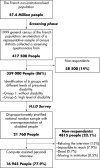Disability in adults with hip and knee arthroplasty: a French national community based survey
- PMID: 12860730
- PMCID: PMC1754638
- DOI: 10.1136/ard.62.8.748
Disability in adults with hip and knee arthroplasty: a French national community based survey
Abstract
Objectives: To compare levels of disability of people with and without hip and knee arthroplasty in a random national sample.
Methods: In 1999 a screening questionnaire to classify people into groups of increasing probabilities of disability was sent to 417 500 people; response rate 86%. The study population was obtained by a stratified randomisation, with a high sampling rate for the most severely disabled group and a minimum sampling rate for people without daily living restrictions. A computer assisted interview to assess levels of disability, dependence, and handicap was given to 21 760 people; response rate 78%. A weighting factor was applied to obtain estimates representative of the French population. The presence of chronic conditions, impairments, and disability was ascertained from the subjects' reports.
Results: The hip and knee arthroplasty group comprised 815 subjects in the sample, indicating an estimated 691 000 subjects (95% confidence interval (CI) 597 000 to 785 000) in the French non-institutionalised population. The prevalence of arthroplasty is estimated at 1.2%. After adjustments for confounding factors, activity limitations were greater among subjects with arthroplasty for the following activities: climbing stairs (odds ratio (OR)=4.0, 95% CI 2.8 to 5.8); walking distance (OR=3.4, 95% CI 2.5 to 4.6 for a walking distance less than 500 m); bending forward (OR=3.2, 95% CI 2.2 to 4.7); cutting toenails (OR=2.8, 95% CI 1.9 to 3.9); carrying (OR=2.6, 95% CI= 1.8 to 3.8); shopping (OR=2.1, 95% CI 1.5 to 2.9).
Conclusions: This study would be useful to policy-makers considering population strategies for managing disabling arthritis.
Figures
Comment in
-
Health status after hip or knee arthroplasty.Ann Rheum Dis. 2003 Aug;62(8):700-1. doi: 10.1136/ard.62.8.700. Ann Rheum Dis. 2003. PMID: 12860721 Free PMC article. No abstract available.
References
MeSH terms
LinkOut - more resources
Full Text Sources
Medical




